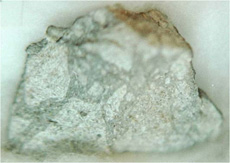Q. Were there any difficulties during your analysis?
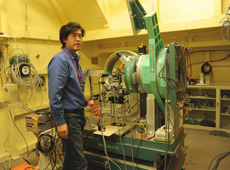
Equipment used to analyze dust from the asteroid Itokawa (courtesy: High Energy Accelerator Research Organization, KEK)
Before HAYABUSA's return to Earth, we worked hard to confirm multiple times how we would analyze the dust particles, and practiced over and over to perfect our approach. Our preparations were thorough, so our analysis went well and produced solid data. I don't think there were any technical difficulties, because the dust particles we analyzed were bigger than we expected - between 50 and 100 micrometers in diameter [1 micrometer = 0.001 mm]. We had assumed the particles would be 10 micrometers in diameter or smaller, so that's what we prepared and practiced for. It turned out the particles were around the same size or a little bigger than the cosmic dust I'd studied before, so there were no problems with the analysis. Nonetheless, I was excited when the first data we produced turned out to be very clean. Everyone in the lab was overjoyed.
The initial handling the dust from Itokawa was far more tricky. I was charged with opening the lid of the HAYABUSA capsule, so I practiced many times to figure out through trial and error how to do it without losing any of the microscopic particles, and how to find the dust inside the capsule. Starting about two years before HAYABUSA's return, I worked every week with Professor Takaaki Noguchi of Ibaraki University and his team. But no matter how many times we practiced, we would have only once chance to open the real lid. I was so nervous when we did the real thing that I thought I was going to die, but I decided to just go for it, and opened up the capsule's seal. It was an incredible relief when I opened the capsule's lid without losing any dust.
Q. How did you feel afterwards, when you got the dust for your analysis?
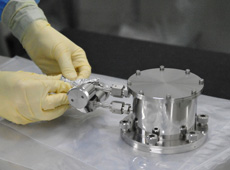
Preparing a transport container used to transport dust particles from Itokawa.
The path leading up to the analysis was long, so I was very emotional. When HAYABUSA's ion engine broke down, I was worried that it might be all over, but I'm glad that we never gave up and were able to pull it off.
The initial analysis team was formed in 2003, when HAYABUSA was launched. From that point on, until the probe's return, we prepared thoroughly so that we could do the best possible analysis. Although the HAYABUSA capsule came back in June 2010, we took our time - we had to be careful opening its lid and checking its contents. That's why it took about six months for us to announce that we had indeed found dust from Itokawa inside the capsule. After that, we divided up the dust particles and distributed them to researchers. When my turn came to perform my analysis, it was already February 2011. This analysis wrapped up my involvement with this project, which lasted about 10 years.
I talked a moment ago about how difficult it was to handle the dust, but another part of that was transporting it. We put it in special containers filled with nitrogen to prevent exposure to the atmosphere, and two people, both traveling on the ground, carried the containers. We would have had a big problem if, after all the trouble we took to fill the containers with nitrogen, we took them on an airplane and one got opened at security. I have a very distinct memory of receiving the suspicious-looking dust container at a train station from JAXA's Akio Fujimura. He'd brought the dust to Yokohama station by train where he handed the dust container to me, and he had a very serious, cautious look on his face. That was the moment when I finally got my hands on humanity's first-ever asteroid sample.
But then, one month later, the Great East Japan Earthquake struck. Tohoku University, where I work, suffered extensive damage, so we had to stop our analysis. That's why we spent only about a month on it. I wrote the paper for Science as the aftershocks continued to hit. I don't think I'll ever forget that time.
Q. What's your impression of other researchers' results?

Electron microscope image of dust particles from Itokawa (courtesy: Tohoku University/JAXA)
At first we wanted to figure out two things. The first was whether asteroids really are the solar system's oldest astronomical objects. The other was more complicated. Asteroids are the parent bodies of meteorites, but they look quite different. We wanted to know whether the surface color and solar spectral reflectance of asteroids are different because asteroids are subject to space weathering. Space weathering causes phenomena such as changes in color from solar wind and cosmic rays (i.e. high-energy particles hurtling through space), and from impacts from cosmic dust.
The answer to the first question - whether asteroids really are the solar system's first astronomical objects - was yes. Our initial analysis proved that to be the case.
Takaaki Noguchi and his team at Ibaraki University figured out the answer to our second question - whether the differences between the surfaces of planets and asteroids are caused by space weathering. When they looked at Itokawa's dust particles using a high-resolution electron microscope, they discovered that on top of the transparent crystals on the surface of the particles, there were incredibly tiny, opaque nanoparticles containing iron and sulfur. These nanoparticles on the asteroid are the result of space weathering. We learned how the asteroid's surface and the granules on it are burned a little at a time by space weathering.
I think it was really great that we could shed light on these two questions, which we thought were the most important ones. We thoroughly accomplished our first objectives. But so far we have only analyzed a few dozen dust particles. I think that's enough for an initial analysis, but there are still lots of particles left, so I believe we'll see plenty more interesting things from them.
Q. What was the response to your paper from your fellow researchers?
There was a very positive response, especially from outside Japan. Scientists had long thought that typical chondrite meteorites were probably fragments of what we call S-class asteroids, such as Itokawa. That was our working hypothesis, but we had no proof. Now, our initial analysis has shown that this is 100 per cent correct. We can now definitively state that that's where meteorites come from. We are all relieved.
Q. What results do you expect from further analysis?
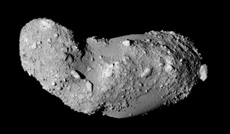
Asteroid Itokawa
Itokawa's rough, bumpy shape is what we call a "rubble pile," which, according to theory, is formed when a larger asteroid is struck repeatedly and shatters into pieces. Some of these pieces then come back together. Our initial analysis has found physical evidence that Itokawa, which is now about 500 meters long, was originally 20 kilometers long, and we have gradually formed an understanding of how rubble-pile asteroids were formed. The next step is to figure out when the original larger body broke apart and at what point the pieces came back together. I think we may be able to determine the age if we can select the proper dust particles for analysis.
Since Itokawa is a very small body, it has hardly any gravity. Therefore, dust flying through space would impact its surface relatively softly, without the speed of a dramatic impact. HAYABUSA may have been carrying dust from astronomical objects other than Itokawa, so I'd certainly like to identify that dust.
I started out studying cosmic dust and meteorites. The dust we got from Itokawa is from its surface, whereas meteorites come from deeper inside an asteroid, so they hold different information. I expect that we'll be able to see the evolutionary process of asteroids in more detail if we proceed with meteorite research along these lines, while continuing to study the dust particles from Itokawa.
Q. NASA has its Stardust Mission, which will bring a dust sample back to Earth from a comet. Like asteroids, comets are small objects in our solar system, but what are the differences between them?
Both asteroids and comets contain a record of the earliest period of our solar system. Where they differ is in their distance from the Sun. While most asteroids lie between the orbits of Mars and Jupiter, comets are farther away. Compared to comets, asteroids are very close to the Sun. That's why scientists say that asteroids represent the primordial stage of the rocky inner planets, such as Earth, while comets, on the other hand, represent the primordial stage of the gaseous outer planets, such as Jupiter. Asteroids and comets have different characteristics. So when we look at both asteroids and comets together, we get an overall sense of what the early solar system was like.
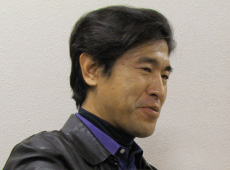
Q. What do you think is the appeal of space exploration?
I think a large part of it is that it makes regular people excited. But what scientists like us love is that we can learn things that we would never know just working here on Earth, no matter how many experiments and analyses we did. In particular, HAYABUSA's sample return mission is incredibly significant for us. That's because a sample is physical evidence that produces indisputable proof. I think it's really amazing that we already have this powerful evidence in our hands.
Q. What kinds of things do you anticipate from future asteroid exploration?
Asteroids are classified according to the characteristics of their solar spectral reflectance. Itokawa is a rocky S-type asteroid that is relatively close to the Sun. The next mission, HAYABUSA 2, will send a probe to a C-type asteroid that contains carbon and is a little closer to the Sun compared to Itokawa, so it may contain organic matter. There are asteroids that are further out, near Jupiter's orbit, so they may be primordial matter from that planet, perhaps containing ice. I'd really like to send a probe to bring a sample back from an asteroid like that - one that could have organic matter and water. I think that would certainly give us a lot of information about the birth of the solar system and the origins of life.
Professor, Department of Earth Science, Graduate School of Science, Tohoku University
Dr. Nakamura graduated the masters program in Mineralogy at the School of Science of the University of Tokyo and he received a doctorate in Science from the same university in 1994. He became an assistant at the Department of Earth and Planetary Sciences, School of Sciences, Kyushu University in 1993. In 2001, he was promoted to assistant professor at the same department. He became a professor of Earth Sciences at the Graduate School of Science, Tohoku University in 2012. His research specialties are planetary science and space exploration.
HAYABUSA's Challenge
Asteroids: The Primitive Objects in the Solar System
Using Oxygen to Trace the Origins of Meteorites
Particles from Itokawa: A Treasure for the World

